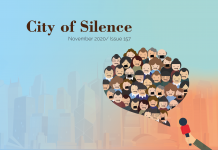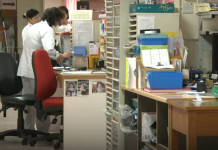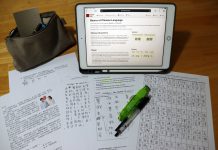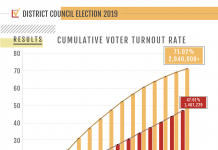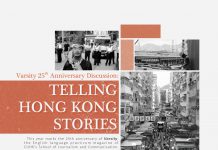Maritime and roadside air pollution takes toll on city’s health, drives out talent
By Tommy Lee and Emily Chung
As shoppers and tourists walk out from the air-conditioned comfort of Tsim Sha Tsui’s Habour City mall, they quickly cover their mouths with their hands. Excited tourists race towards the harbour with their cameras ready, only to be left disappointed. All they see is a murky haze and thick, heavy smog instead of Hong Kong’s iconic and impressive skyline of high-rises.
These days, blue skies are a rarity in the city. But air pollution is not just a blight on the scenery, it is harmful to our health and affects our daily life. According to the Hedley Environment Index by the University of Hong Kong, poor air quality accounts for over 3,000 premature deaths per year and incurred HK$39 billion in economic losses in 2012.
Power plants used to be Hong Kong’s biggest polluter but the focus is now shifting to maritime pollution. Marine vessels became the largest source of respirable suspended particulates, nitrogen oxides and sulphur dioxide in 2011, a fact that was recognised in the Chief Executive’s last policy address. Also, a study by the policy think-tank Civic Exchange shows ships at berth accounted for 40 per cent of total emissions within Hong Kong waters.
To deal with the marine pollution, the shipping industry has taken the initiative to regulate the emission from liners. In November 2010, 18 private shipping companies collaborated with Civic Exchange to establish the Fair Winds Charter (FWC). They voluntarily signed up to burn fuel with a sulphur content of no more than 0.5 per cent while at berth in Hong Kong. Currently, most ocean-going vessels employ cheaper and dirtier bunker fuels with sulphur content of between 2.8 per cent and 3.5 per cent.
But not all the industry players have joined the clean-up act. There are around 200 companies operating in Hong Kong, but only 18 of them participated in the FWC.
“Obviously that has come at a high cost,” says David Skov, South China head at Maersk Line, one of the companies which spent over HK$1 million as part of the FWC. “For competitors who are not joining, it means they can reduce their costs compared to us.”
Although there is resistance from individual companies, a major industry group has thrown its weight behind the scheme. In fact, the Hong Kong Shipowners’ Association is a co-founder of the FWC and is lobbying the government to impose regulations requiring the use of cleaner fuel while vessels are at berth in Hong Kong. With such a regulation, all the companies would be competing fairly.
“It is important that we reduce air pollution in Hong Kong because we live here and our children live here,” says Arthur Bowling, the managing director of Hong Kong Shipowners’ Association. While FWC was a first step and very short term, its aim was to inspire the government to take further action, he explains. “With regulation, we can restore the level playing field in the competition. We are very keen for the government to introduce regulation.”
The FWC had been due to expire last December, but the shipping companies agreed to extend the contract through 2013 as the government promised it would introduce regulation. Chief Executive Leung Chun-ying vowed in his first policy address in January to enact legislation to enforce the requirement of the fuel switch when ships dock later this year.
Leung also took up the issue of on-shore electricity supply in his maiden policy address, a timely measure as the new Kai Tak Cruise Terminal is due to open around June. Space has been reserved to install an on-shore electricity facility at Kai Tak although the HK$14 billion funding proposal is still under consultation.
When ships dock at the Kai Tak Terminal, they need to keep burning fuel to provide energy and electricity. It causes heavy air pollution but an on-shore supply would solve the problem and ensure there were no emissions in the immediate area.
Simon Ng Ka-wing, head of Transport and Sustainability Research at Civic Exchange, says shore power will benefit residents in the Kwun Tong area the most as there will be no emissions at the site. Instead emissions will be transferred to power plants in rural areas, where pollution is widely dispersed and easily monitored.
However, Ng says the setting up of shore power is not an easy task. Not all cruise liners are equipped with the facility for shore power, and there are technical difficulties with power distribution and wiring. He adds that the ownership by the government and operation by the private Worldwide Cruise Consortium could lead to inefficiencies in any potential arrangement. Within the government structure, there are further divisions, with the Hong Kong Tourism Board taking a leading role. This means for instance, that the Environmental Protection Department does not have a say in the construction process.
In other words, on-shore power is not going to provide a cure for all or even some of Hong Kong’s marine pollution problems, at least not in the short-term.
“It will take at least two to three years for on-shore electricity to be set up in Hong Kong. But this [switching to low sulphur fuel on the other hand] provides a quick fix,” says Ng.
This helps explain the idea of establishing Asia’s first Emissions Control Area (ECA) – a maritime territory where all ships are required to burn fuels with a maximum of 1 per cent sulphur. There are currently only two such areas in the world, one in the United States and the other in the Baltics.
According to Tony Lee Yu-tao, senior environmental protection officer at the Environmental Protection Department, the Hong Kong, Shenzhen and Guangdong governments started discussing the possibility of a pan-Pearl River Delta ECA last September. However, he says the project is complex and involves many stakeholders, so there is no timetable yet.
While the battle against maritime pollution is gaining ground, the public’s response to the government proposals to reduce roadside pollution has been mixed. The government is to launch a HK$10 billion programme to eliminate old diesel vehicles which will mean some 80,000 pre-Euro and Euro I to III vehicles will be phased out to meet the 2015 and 2020 emission reduction targets.
The term “Euro” refers to the European emission standards that define the acceptable limits for exhaust emissions of new vehicles sold in European Union member states. The latest standard is Euro V. Old diesel vehicles with pre-Euro and Euro I to III emission standards are highly polluting.
One common complaint about the scheme is that the subsidies for scrapping an old vehicle are too low. Under the current plan, vehicle owners can get a subsidy of 18 per cent to 30 per cent of the price of a new vehicle, according to the age of the vehicle they have. For van and truck drivers who depend on their vehicles for their livelihood, making up the shortfall is a headache.
“Even after the government has paid 30 per cent, we still have to pay for 70 per cent of the price of a truck,” says Stanley Chiang Chi-wai, chairman of Lok Mau Chau China-Hong Kong Association. This means the owner will have to pay more than HK$700,000 for a new truck, as a heavy duty truck now costs over HK$1 million because of the drastic price inflation in recent years. Chiang says he suspects that suppliers have deliberately jacked up prices in anticipation of a rise in demand.
He is unhappy with what he sees as the way the government has pit the trucking industry against the public. “The Environmental Protection Department has said a lot of negative things about my industry, leading the public to view the industry as polluters,” says Chiang. “The public may think, why do I need to pay for the polluters? I would however, urge the public to realise that all trucks contribute to the livelihood of Hong Kong residents by transporting goods.”
Nonetheless, Chiang says the industry is willing to upgrade their vehicles, as long as subsidies fall within an acceptable range and the compensation payment is a one-off sum with no strings attached. “After all, we don’t want the public to have a bad image of us,” says Chiang.
Patrick Fung, campaign manager of the Clean Air Network, says the previous government did not take research on roadside pollution and maritime pollution by academics and NGOs seriously. He hopes the new Leung government will do a better job.
Before common ground can be reached between different interests, Hong Kong may stand to lose many talents in the business sector. A survey by the American Chamber of Commerce (AmCham) found that over 30 per cent of respondents had difficulty recruiting as a result of air pollution. The same survey also reveals that 48 per cent of respondents are considering leaving Hong Kong.
“I have considered leaving Hong Kong,” says Evan Auyang, chairman of the Environment Steering Group of AmCham. He says the figure could have been higher, as some people will not even consider coming to Hong Kong, especially for those who have young children and elderly parents.
It is not just those in the business sector who are considering leaving. James Matthews is an English teacher and examiner in the International English Language Testing System (IELTS). His life is adversely affected by the air pollution.
Matthews is a long-distance runner but the poor air in Hong Kong prevents him from practising his hobby. He used to run three times a week but now he sometimes runs just once a week, depending on the air quality. Before he runs, he checks the website for the Hong Kong Air Pollution Index.
The 47-year-old is very sensitive about air pollution because he had a bad experience of running when the air quality is poor. Matthews participated in the Hong Kong 100 Ultra Marathon in January and successfully completed the race but he felt very uncomfortable.
“I started to wheeze like I had asthma. I am very, very fit. I exercise a lot so it wasn’t my heart or my lungs, it wasn’t lack of training,” he says. “The day we had the race was an average day for Hong Kong but the pollution was high and I’ve got no doubt my wheezing is the result of pollution.”
Matthews is considering leaving Hong Kong after retirement. He finds the food, security and convenience of Hong Kong attractive, but health is his biggest concern. “The only reason I would have to leave is because of pollution; 24 hours a day, seven days a week, I am breathing in the air which is damaging my health,” he says. The poor air quality is making Hong Kong an uninhabitable city for him.
In the meantime, he has bought some air filters for his home to make the air quality suitable for living. But he knows this cannot solve the root problem. He would need to keep the filter on, the windows closed and stay indoors. But once he leaves home to go to work, to teach, he breathes the normal Hong Kong air which he describes as “toxic”.
Even on a perfect day with a blue sky, Matthews says he is always aware that something is not quite right, “It’s a beautiful day, I live next to a park and I walk into the park. The sun is shining and it’s warm. You feel very, very good because it’s warm and beautiful but you don’t realise the pollution. It’s there. Even though you can’t see it, you are breathing it in.”




